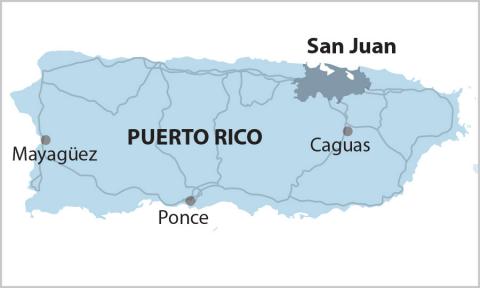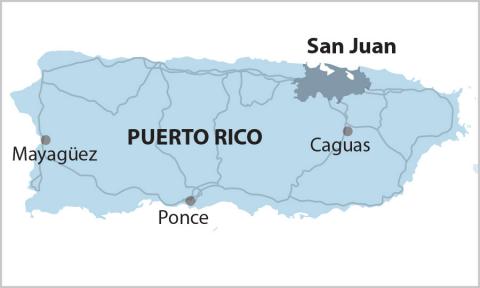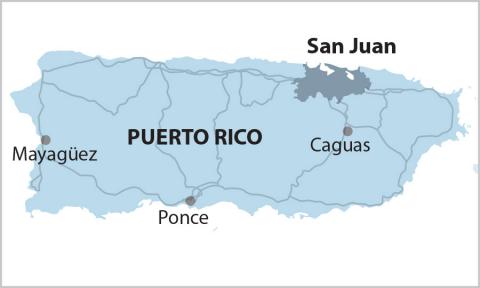Bondholders hoping to recover bad debt from struggling Puerto Rico ratepayers
Key Findings
Financial Oversight and Management Board, Puerto Rico Electric Power Authority at standstill over $8.9 billion debt deal
Court filings indicate 50-year-long “connectivity charge” sought by bondholders
Deteriorating Puerto Rico economy leaves little room for large recovery of bond debt
Almost $9 billion in bad debt and a half-century of high electricity prices hang in the balance in Puerto Rico.
The federal Financial Oversight Management Board (FOMB) and bondholders of the Puerto Rico Electric Power Authority (PREPA) are at a standstill after almost six years of negotiations. The latest round of PREPA bond discussions ended on Sept. 16 without an agreement, marking the third rejection of a proposed debt restructuring.
Bondholders wanted a new $26 monthly “connectivity charge” per customer, amounting to a 2.87 cent-per-kilowatt-hour (c/kWh) increase in the price of electricity. The “connectivity charge” would amount to a long-term price hike, lasting for 50 years and tied to inflation. The renegotiated interest rate on bonds would be 6.75%.
Under the proposal, bondholders would achieve a recovery rate of 60% to 80%. A recovery rate represents the percentage of the original investment returned to the bondholders to settle the bankruptcy. The figure would mark a very high recovery, given Puerto Rico’s weak economy.
The FOMB proposed a rate increase of 2.6 c/kWh, with bond interest of 6% over 35 years that would result in a bondholder recovery rate of 70% to 89%. The FOMB proposal states that the revenues would be used exclusively to pay debt services and could not be used to support PREPA’s fiscal plan. At the end of 50 years, any balance on the bonds would be extinguished.
The bondholders said the FOMB proposal did “not materially impact” affordability. In the same document, they suggested that if the island’s government thought it necessary to subsidize the rates, it could pay for it from the commonwealth’s annual budget.
There was no explicit reason given why the parties could not bridge their differences. But one suspects that the bondholders knew the deal was not affordable: Why propose a subsidy arrangement otherwise? One also suspects the FOMB knew that the repayment scheme was unrealistic. Why propose a deal where the bonds would be paid off in 35 years, but continue to make refinancing provisions for 50 years?
Why a deal fell apart
There are a couple of reasons why the deal might have fallen apart. Fundamentally, PREPA’s revenue base cannot carry its $8.9 billion debt load.
In early 2015, Moody’s Investor Services gave Puerto Rico a relatively positive outlook and recovery rate. Then, the outlook deteriorated. In August 2015, Moody’s assumed recovery rates would be between 65% and 80%, based on progress reported during restructuring negotiations. By July 2018, however, Moody’s projected that recovery rates were likely to be “below 35%.” The credit rating agency has reported on restructuring negotiations and discussed the possibility of proposed deals, including a 68% recovery rate. But the credit agency has not changed its long-term estimate, maintaining that recovery rates will be less than 35%.
The Moody’s review considers the fundamental fact that the Puerto Rico economy is shrinking. Nothing in the legal mediation process—including the threat of judgments that impose burdensome recovery rates on PREPA and its ratepayers—can change this fact. A legal claim secured by bondholders by anticipated revenue from PREPA when the economy cannot produce that money is an empty deal. Pressuring the utility into revenue and expense initiatives that cannot work is foolish. In April, Moody’s issued another warning that not only PREPA but also the entire commonwealth’s financial position is at risk from inflation and energy costs.
IEEFA has taken a more practical approach, which acknowledges the need to pay back the bondholders—but not at the expense of ratepayers. There are insurance policies to protect some bondholders. There are also ways for the bondholders and underwriters who sold the bonds to the holders to work out their differences—but again, not at the expense of ratepayers.
While the mediation settlement process looks at the long term for Puerto Rico, the current environment will influence the long-term view. During this most recent mediation process, the price of electricity hit 33 cents/kWh. The price has declined some but it is still far above the legislative target of 20 cents/kWh endorsed by the FOMB. The price goal is designed to induce broader economic growth incentivizing businesses to invest by minimizing the share of household income that goes to utility bills. Moody’s agrees that using profits and wage growth to pay for energy costs is a drag on economic growth.
Finally, there is the reality that PREPA and LUMA Energy, the private grid operator, cannot control operational costs. LUMA and PREPA have done virtually nothing to reduce the impact of rising fuel prices on customer bills. During times of high oil prices, fuel costs consume more than 50% of the rate dollar.
Big mistakes can still be avoided
Admittedly, there is little anyone in Puerto Rico can do to bring down oil and gas prices given Russia’s decision to invade Ukraine. Puerto Rico’s more affluent residents however have taken matters into their own hands by installing solar panels on their homes. This can both reduce household costs and improve reliability for individual households during hurricanes.
But there are numerous short- and long-term steps that LUMA and PREPA can take to help the residents of Puerto Rico protect themselves against the elements. New incentives for more rooftop solar panels are one obvious approach, but the most recent fiscal plan suggests that PREPA and LUMA are working to curtail self-help approaches.
There are also obvious opportunities for PREPA and LUMA to create and distribute short-term tools to use during a storm and its aftermath. Practical, inexpensive survival kits can be put together. A little creativity here could save lives. For example, during outages caused by storms some community organizations have gotten together and raised money for “solar lanterns” that produce light and can charge cell phones. The sun will shine faster than PREPA can get the lights back on, and a fully charged cell phone is a lifesaver.
Finally, PREPA has received commitments for $12 billion from the federal government as a down payment to rebuild the electricity grid. This can be spent wisely or it can be used badly. Right now, PREPA and LUMA are supporting the development of natural gas plants and associated terminals and transport infrastructure. The expenditures are maintaining Puerto Rico’s reliance on fossil fuels and will keep electricity rates high; during some periods, very high.
LUMA, PREPA, Wall Street and the fossil fuel companies are working to pile on more and more costs. Collectively, they are making counterproductive choices for Puerto Rico’s residents and its economy. This is a formula for bankruptcy. Think about it: Ratepayers are being asked to pay for debt incurred some 20 or 30 years ago for the next 50 years. That means in 2070, Puerto Rico ratepayers will be paying off obsolete technologies like Selectric Typewriters and fax machines bought by PREPA in the 1980s and 1990s.
This week, a new plan will be put forward. Let’s hope this one does not saddle ratepayers with debt that no one can afford. The public has borne its share of the burden of a poorly run electricity system. They need leaders who are real and solutions that work.
Tom Sanzillo ([email protected]) is IEEFA director of financial analysis


















